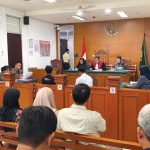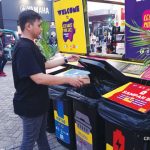Jakarta (Greeners) – Waste-to-energy plant in Bantargebang, Bekasi, finally inaugurated on Monday (25/3/2019) in Bekasi, by Coordinating Minister for Maritime Affairs, Minister of Research Technology and High Education, Director General of Waste Management, Toxic and Hazardous Substance of Ministry of Environment and Forestry, and Head of Agency for the Assessment and Application of Technology.
The plant, dubbed as Merah Putih, is ready to manage waste up to 100 tons per day and produce 700 kilowatt of electricity. It will serve as national pilot project to tackle waste volume in major cities.
Hammam Riza, head of Agency for the Assessment and Application of Technology (BPPT), said Merah Putih Plant applies thermal technology with incinerator type using reciprocating grate. This technology is chosen because it’s has been applied to plenty of waste-to-energy plants in the world, environmentally friendly as it’s equipped with pollution control device, economical, and can be used for type of waste in Indonesia, also it has high level of domestic components.
“The main equipment from waste-to-energy plant comprises four instruments, — bunker to contain waste, platform, grab cane, and burning chamber with reciprocating grate designed to burn waste above 850 degrees Celsius so dioxin and furan can be minimized,” said Riza in Bekasi. “The heat carried by gas resulted from burned waste is used to boil water in boiler to steam, which will turn turbines to produce electricity.”
READ ALSO: KLHK to Issue Regulation on Tipping Fee Subsidy for Waste Management
The waste-to-energy plant also has Air Pollution Control unit to clean hazardous substances carried by exhaust gas, so the gas will meet the standards. In addition, there is pre-treatment unit to sort certain waste not suitable for the plant, such as metal, glass, rock, toxic and hazardous waste and large size waste.
Coordinating Minister for Maritime Affairs, Luhut Binsar Pandjaitan, said that the waste-to-energy plant is produced by Indonesians. With this facility, to turn waste into thermal energy can use the country’s own technology and not foreign technology.
“The waste-to-energy plant development started in December 2017 as President [Jokowi] was already upset, because waste issues was unsolved since he was a mayor [in Solo city]. So, we will speed up with lots of regulations, it can be finalized, said Minister Luhut. “Bantar Gebang waste-to-energy plant is going to be a pilot project for other areas or regions, such as Labuan Bajo, Balige, Pontianak which produce 100-200 tons, to be implemented in their own areas. The rules are there, just need to harmonize them.”
READ ALSO: BPPT Develops Small Capacity Waste Fueled Power Plant to Reduce Its Volume
The waste-to-energy is part of National Strategic Projects stipulated under the 2017 Presidential Regulation on National Strategic Infrastructure Project. The implementation is regulated under the 2017 Presidential Regulation on National Strategy Policy and the 2018 Presidential Regulation on Environmentally Friendly based Waste-To-Energy Installation Acceleration, which prioritizing on 12 major cities in Indonesia, one is DKI Jakarta.
Meanwhile, Yusmada Faisal, assistant of DKI Jakarta development and environment, said that the-115-hectares Bantar Gebang landfill can only sustain until 2021. With increasing waste volume, DKI Jakarta is predicted to have waste emergency if it is not properly managed.
“The Bantar Gebang landfill can only accept 7,000 tons of waste per day collected from Jakarta cities and 1,200 waste trucks. Hence, we need to think of solution of how to end sanitary landfill process in Bantar Gebang. One of the solutions is with waste-to-energy plant and ITF Sunter which will be finalized in 2021,” said Faisal.
Reports by Dewi Purningsih



















































